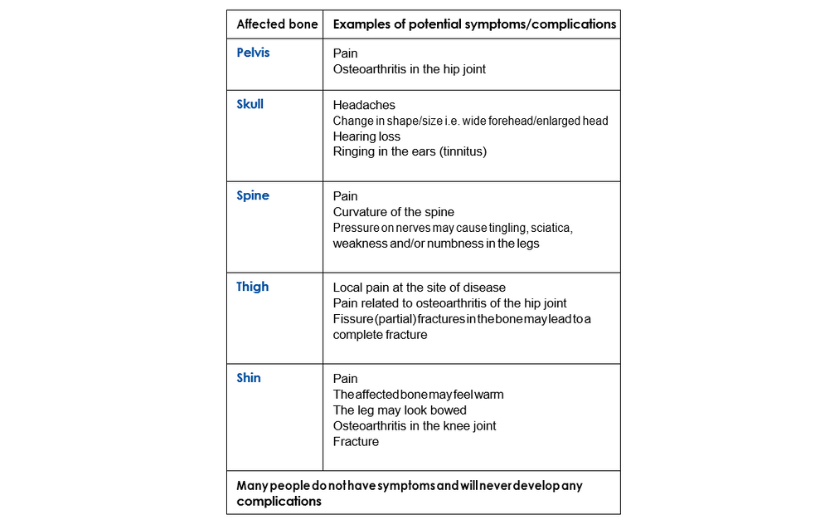Symptoms and complications
- The symptoms of Paget’s disease vary widely
- Many people who have Paget’s disease do not have symptoms and never develop complications. In many cases, individuals are unaware that they have the condition
- Of those who present with symptoms, pain is the most common. Pain may arise from the affected bone itself, or from the altered biomechanics as the result of limb deformity; for example, a bowed leg alters the way you walk and puts stress on the joints and soft tissues
- The blood flow to active areas of Paget’s disease increases and this can lead to a feeling of warmth over the affected bone
- The affected bone may become enlarged and misshapen
- The potential for complications will depend on which bones are affected by Paget’s disease
- Complications may require medical or surgical intervention
Examples of potential symptoms/complications

Deformity
Paget’s disease can cause bone to become enlarged and misshapen. For example, if the skull is affected, the enlarged bone is sometimes first noticed when the individual becomes aware that their head is larger and their forehead may be wider than normal. Long-standing disease over many years may cause the weight-bearing bones of the leg to develop a bowing deformity.

Deafness
If the skull is involved, hearing loss can occur.
Fracture
There is an increased risk of fracture, particularly in the long bones of the arm and leg. Fractures may initially be incomplete, (stress fractures or fissure fractures), which are at high risk of complete fracture. Fissure fractures predominantly, but not exclusively, affect weight-bearing bones, such as the thigh bone (femur).
Osteoarthritis
Paget’s disease can predispose to the development of osteoarthritis at adjacent joints.
Neurological complications
Neurological complications can occur, often because of bony overgrowth leading to compression. For example, enlargement of vertebrae in the spine can produce pressure on nerves causing pain, leg weakness or sciatica.
Increased vascularity
Should the bone fracture or surgery be undertaken, active Paget’s disease has the potential to result in excessive blood loss. This is because blood flow increases to areas where Paget’s disease is active.
Heart disease
Paget’s disease does not directly affect the heart but if it is in many bones, is highly active and uncontrolled, the heart may have to work harder to pump extra blood to the affected bones. Whilst heart failure due to this increased blood flow has been reported, it is extremely rare.
Osteosarcoma
An unusual and very rare complication of Paget’s disease is a type of bone cancer called osteosarcoma. This occurs in less than 1:1,000 people with the disease. If you have any questions or are worried about this, please contact our Helpline.
Paget's Nurse Helpline
Contact the Paget's Nurse Helpline for information and support on all aspects of Paget’s disease
Facts about Paget's disease
Membership
Become a member of the Paget's Association
Join today to unlock a world of insights into Paget's disease and support our cause.
As a valued member, you'll receive a comprehensive Paget’s Information Pack, along with our regular Paget's News magazine.
Stay at the forefront of advancements with our latest news: research, treatment and more.
Don't miss out – explore the benefits of membership now!
